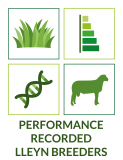Ed Brant, Lincolnshire 2616
Ed Brant farms with his parents in the Lincolnshire Wolds. The farm is a mix of grazing (sheep and cattle) and combinables split into a third and two thirds respectively. Grazing ranges from
herbal leys in the arable rotation to more extensive grazing in environmental schemes on hillsides and valleys
where topography and archology don’t allow cultivation.
The sheep flock is made up of two performance recorded flocks the Lleyns and Hampshire Downs (for terminal lamb production and the sale of excess rams). The first 80 Lleyns arrived on the farm in
2016 and after a few years of pedigree recording, performance recording with Signet began.
Over the past 9 years rams have been brought from the Thistleyhaugh and Stonehouse flock. The rams were selected with an emphasis on moderate mature size, ewe production traits, parasite resistance and lamb survival. Over the past couple of years shedding genetics have been used on the ewe lambs, to build up a shedding flock based on the best Lleyn genetics.
Sheep are grazed on a mixture of permanent and herbal leys during the summer with priority given to weaned lambs. In the winter ewes are grazed on grass, fodder beet and cover crops ahead of spring
arable crops.
Fact file:
Location: Lincolnshire wolds
Flock size/makeup: 550 ewes, mainly pedigree Lleyns, a flock of Hampshire downs and a few crossed onto shedding rams
Flock number: 2616
Proud achievement: Being selected to represent the UK in the Global Sheep Forums Next generation program
Advice you give yourself looking back: Keep things simple
Next target looking forward: Build a better system where grazing and combinable are more symbiotic and flow together better.
What are you doing in March: We have just had our ewes scanned and are moving them off their winter forage crops onto grass, where before lambing in April (plus all the bits that are in the month or so before lambing).






